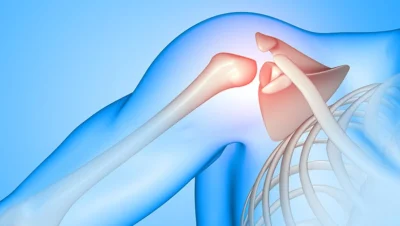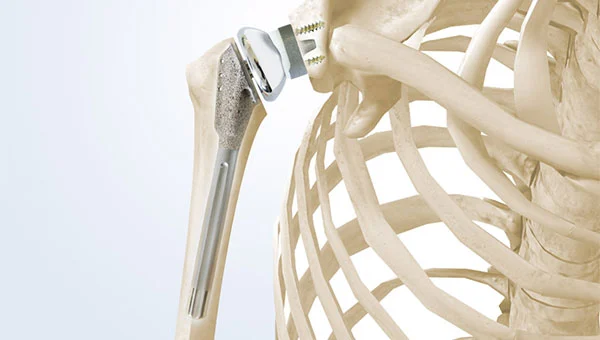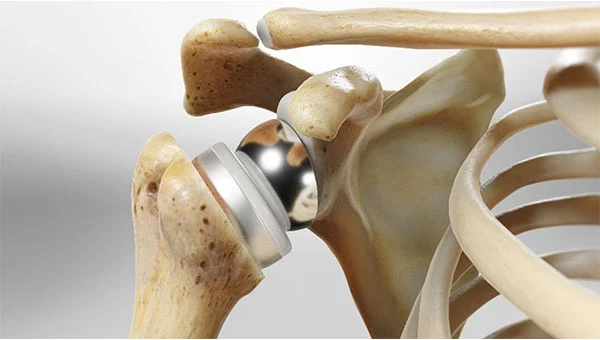Free Consultation Form
Anatomy Of The Shoulder

The shoulder is a joint with ball and socket. The round head-ball of the upper arm bone sits in a shallow slot in the shoulder. Damage to the joint can cause pain, weakness and stiffness.
Shoulder replacement surgery
A shoulder replacement removes damaged areas of bone and substitutes implants made of metal and plastic. This
surgery is called shoulder arthroplasty. Shoulder implants are available in several different forms and in various sizes. Replacement options include the part and total in which anatomical or reverse implants are used. Shoulder replacement surgery is done to relieve pain and other symptoms caused by damage to the shoulder joint.
What Diseases is Shoulder Replacement Surgery Performed For?
In diseases with pain and movement restriction in the shoulder, shoulder replacement surgery is applied in cases where the patient’s complaints are not passed with medication and lifestyle changes.
What Diseases is Shoulder Replacement Surgery Used For?
- Shoulder joint calcification
- Rheumatic diseases with progressive damage of the shoulder joint
- Avascular necrosis, in which the feeding and structure of the humerus head is disturbed
- Multipart humerus fractures with low probability of functional boiling
- “Cuff tear arthropathy” caused by long-term rotator cuff muscle tears
Osteoarthritis, known as shoulder replacement surgery, wear and tear arthritis, damages the cartilage lining the ends of the bones and helps the joints move properly.
Shoulder replacement surgery is used to treat rotator cuff injuries. The rotator cuff is a group of muscles and tendons surrounding the shoulder joint. Rotator cuff injuries can sometimes cause damage to the cartilage and bone in the shoulder joint. It is used in this type of treatment.
Shoulder replacement surgery, fractures in the upper end of the humerus, may need to be replaced as a result of the injury, or if the previous surgery failed to detect a fracture. In this case, apply.
Shoulder replacement surgery is used to treat rheumatoid arthritis and other inflammatory disorders. The inflammation associated with rheumatoid arthritis caused by an overactive immune system can damage the cartilage and sometimes the bone beneath the joint. It is used to prevent damage.
What Are The Different Types of Shoulder Replacement?

Total Anatomical Shoulder Replacement
The humerus head, which forms the joint with a total anatomical shoulder prosthesis, is replaced with synthetic materials in a way that mimics the glenoid normal anatomy. In the long term, it has been the most frequently applied shoulder replacement type in the world. In order to achieve successful results with total anatomical shoulder prosthesis, the rotator cuff muscles must be solid and functional.
Partial shoulder replacement
In the partial shoulder prosthesis, only the humerus head is replaced instead of both surfaces that make up the joint. The conditions in which partial prosthesis can be preferred are humerus head fractures, which are predicted that proper boiling cannot be achieved, calcifications where only the humerus head is affected, and avascular necrosis where the feeding of the humerus head is disturbed. The prerequisite for partial prosthetic surgery is the presence of solid and functional rotator cuff muscles.


Reverse Shoulder Replacement
In reverse shoulder replacement, both surfaces forming the joint are replaced. In this respect, although it resembles total anatomical shoulder prostheses, it has an important difference. In the reverse shoulder prosthesis, the round-shaped synthetic material is placed in the glenoid, which is the extension of the shoulder bone, while the synthetic material that will act as a nest in this round structure is placed in the upper arm bone. The reason why this type of
prosthesis is called “reverse shoulder prosthesis” is this difference.
What Should be Considered After Shoulder Replacement Surgery?
In general, the hospital stay after surgery is 2-4 days. On the first day after the operation, the person is encouraged to eat his own food with the elbows on the table. the arm strap is used for 4-6 weeks. It is not appropriate to lift more than 2 kilograms during this process. Usually, a control examination is carried out at week 2 and week 6. According to the findings of the examination, a unique exercise program is created for each person.
How Long Does Shoulder Replacement Last?
If the right techniques are done, the shoulder prostheses can be used without problems for an average of 20 years. after 20 years, wear and tear can be seen in the prostheses. If wear is seen, a second surgery is performed and the prosthesis is changed.